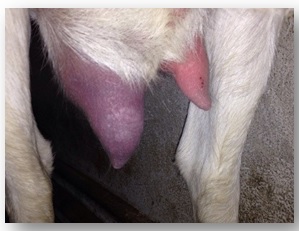
Goat Pregnancy Calculator
Estimate when your goat is due to give birth by entering the date of the first mating below and stay prepared for additions of new baby goats to your family!How Long Are Goats Pregnant?
With fall just around the corner, goat breeding season is closer than ever. For the most part, goat breeding, pregnancy, and kidding are usually uneventful especially if the doe is healthy. However, it is still important to understand their pregnancy process, risks, and whatever needs they may have.
A goat pregnancy lasts 150 days on average but can range from 145 days to 155 days. Their pregnancies are usually divided into 3 stages. These are the breeding stage, early pregnancy, and late pregnancy stages.
In the sections below, we shall take a look at these 3 stages in terms of what you can expect and how best to take care of the pregnant doe. We shall also take a look at the kidding process and important care points during the postpartum and neonatal period.
Without further ado, here is everything you need to know about goat pregnancies.
Breeding period
What to expect
Goats are referred to as fall breeders because, as the name suggests, they typically breed during the fall. For you to identify whether or not your goat is ready to breed, you need to understand their heat cycles.
Goat heat cycles occur at intervals of about 21 days, give or take a few days. Once the doe gets into heat, they have a14 to 48 hour window to copulate for successful fertilization and commencement of the pregnancy.
Understanding the goat’s heat cycle will also come in handy if you practice artificial insemination.
Whatever the case, here are a few telltale signs that your doe is in heat so you know when to prepare for the breeding.
- Increased frequency of urination.
- Unusual behavior which could either be increased goofiness and affection or increased aggressiveness.
- Reduced appetite with or without avulsion to certain goat feeds that they previously didn’t mind.
- A sticky tail coated by the doe’s vulval discharge.
- Increased vocalization with prolonged episodes of loud bleating with no apparent trigger.
- Tail wagging. This is actually referred to as “flagging”.
- The doe may mount other goats in the herd. They are also usually more receptive to mounting by bucks.
How to care for the goat
Taking good care of the doe during the breeding stage is crucial to helping ensure that they have a healthy and successful pregnancy. Now that you know what to look out for to confirm that your goat is in heat, here are a few care tips you can work with.
Weight maintenance
Ideally, the doe should be at least 65% of the expected adult weight for a female goat. If they are underweight, the chances of successful breeding are very low.
In the unlikely event that the underweight doe gets pregnancy, they are more likely to suffer complications during the pregnancy, kidding, and postpartum periods.
Therefore, if you plan on performing artificial insemination, it is best to wait until the goat is of a healthy enough weight to support the pregnancy.
Deworming
Pregnancy is a very high stress state for the goat. The last thing you want your goat to be going through is dealing with parasites sucking up their life force as the goat is actually creating life.
Deworming during the breeding period is therefore very important to help prevent pregnancy complications in goats including toxemia which shall be discussed in detail shortly.
Diet and supplementation
A healthy and adequately balanced diet is the best thing you can do for a goat in heat to help prepare them for breeding and pregnancy. At this stage, high quality hay should do the trick.
However, if the doe is concurrently breastfeeding other kids, you may have to add grains to their meal plan.
In addition to this, consider supplementing micronutrients like vitamin E. Your veterinarian may also recommend selenium supplements in case you are in a region where selenium deficiency is prevalent.
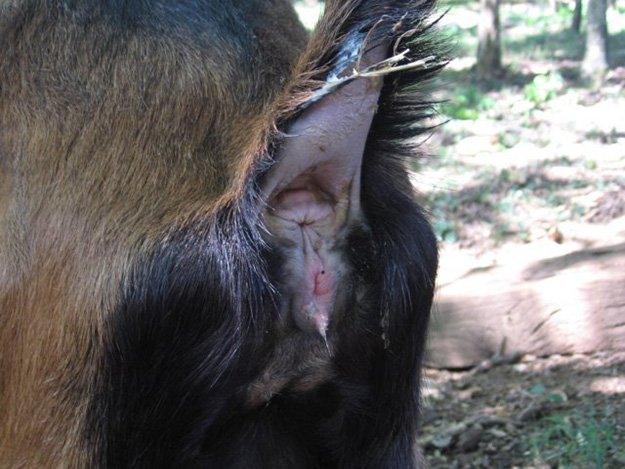
Early pregnancy (Day 0 to Day 105)
What to expect
The early pregnancy period in goats starts from the point of successful fertilization and implantation to 105 days or 3 ½ months.
For the most part, this is the easiest part of the goat’s pregnancy.
The process starts on strong day 0 when the female goat’s ovum is fertilized | by sperm from the buck. This is known as the zygote stage with the fertilized egg then undergoing several stages of cell division. strong At around the 8th day, it will have transformed into a ball of rapidly dividing cells. | At this stage, it is referred to as a blastocyst and it should have reached the uterus.
Between day 14 and 16, implantation occurs and the placenta begins to develop.The placenta is what will act as a conduit between the doe and their fetus for nourishment of the latter and clearance of waste.
Once implantation occurs successfully, what follows are 3 ½ months of very slow development of the embryo.
By day 20, you may be able to hear a heartbeat especially on ultrasound.The growth and development are, in fact, so slow that you may not notice any obvious changes of pregnancy in the doe during this season.
While the pregnant goat may not have obvious body changes, there are a few clews that you may notice to let you know that the goat may be pregnant.
- A sudden increase in appetite.
- Reduced milk production for goats that were still breastfeeding.
- Increase in size. This is usually uniform and not just around the belly area.
- Increased abdominal tension.
- Gradualincrease in the size of the udders that is most notable during the 12th week.
In addition to these signs, you could perform various tests to confirm whether or not your goat is pregnant. strong The best time to do a pregnancy lab test on the goat is at the 30 day mark or after that.
You could also do an ultrasound to confirm that the goat is pregnant as well as figuring out other details like the number, location, and viability of the embryos. strong Ultrasounds on a pregnant goat will yield the best results when done at or after the 40th day of the pregnancy.
How to care for the goat
While not much changes about the goat and their embryo/fetus during the long early pregnancy stage, there is still a lot that needs to be done to ensure that the goat is healthy and at peace for a successful pregnancy.
Here are a few care tips for your pregnant goat during early pregnancy.
Reduce their stress levels
When a goat is stressed during their early pregnancy, they are very likely to reabsorb the embryos and effectively terminate the pregnancy. It is therefore crucial that you keep the pregnant doe in a low-stress environment. This includes:
- Avoid switching them to a new herd, pen, or grazing area.
- Avoid adding new goats to the herd.
- Limit confrontations with other goats even if that means isolating the doe.
- Avoid excessive and stressful grooming including trimming the hooves.
Ensure a healthy and balanced diet
Your goat may not be ballooning dramatically but their nutritional needs are still going to be very high. We recommend you consult your veterinarian on the amount of food to feed your pregnant goat. This is because the requirements are different for each doe based on factors like their size, age, and the number of embryos they are carrying.
Limit milking
For pregnant goats that are still being milked or that are still breastfeeding, you should strong stop the milking at about 12 week mark. | This is important because the milk production takes much-needed energy and nutrients from both the doe and their embryos.
Avoid giving them any drugs
You should not give your goat drugs during early pregnancy especially between days 25 and 30.This is because it is during this time that the embryo is undergoing rapid cell division and differentiation.
If any of the drugs they happen to take happen to be known teratogens, there is a very high chance that the resulting kids will be born with deformities. The exposure to drugs during this critical period also puts the goat at a risk of suffering a miscarriage.
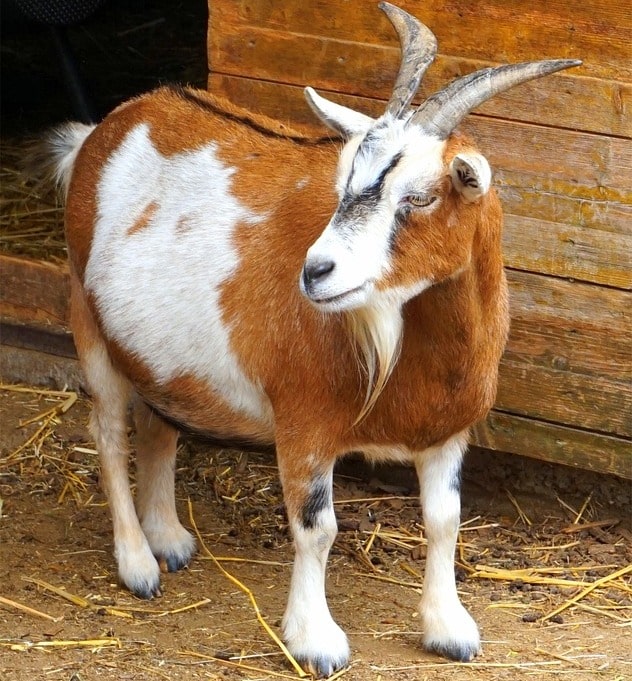
Late Pregnancy (day 106 to the kidding)
What to expect
The late pregnancy stage spans the last 6 weeks of the goat’s pregnancy.This is a stage of rapid growth for the fetus and therefore calls for increased support for the goat.
During late pregnancy, you will notice a sudden increase in the goat’s size. Their bellies seemingly balloon overnight with increased fullness of the flanks.
If the goat is carrying one fetus, the increased size may be asymmetrical while those carrying multiple fetuses tend to have more uniform abdominal distention.
Inside the goat’s womb, the goat continues to develop and mature. By strong day 112, their lungs should be almost fully developed with the process reaching completion a few days before the kidding.
The goat will also have a dense coat of hair over their entire bodies. The strong teeth buds are also fully erupted and mature by day 119.
How to care for the goat
Taking care of your goat during the late pregnancy stage is crucial for ensuring the survival of both the goat and their kids. Here are a few care tips.
Increase the food volume
The fetus or fetuses inside the pregnant goat go through a lot of growth and development during late pregnancy. This increases the goat’s nutritional needs greatly. We recommend that you increase the goat’s feed volumes and frequency to support these needs.
Again, a quick consult with your vet should help offer guidance on just how much you should give your goat based on their specific situation and needs.
During this stage, the goat’s diet should include high quality hay or other pasture, mineral supplements, and grains. You could switch out your regular hay for alfalfa which is typically enriched with important micronutrients that both the goat and the fetuses need.
Vaccinate the goat
About 2 weeks into the late pregnancy stage or strong day 119 of the pregnancy, the goat should receive a CD&T vaccine | . This protects both the goat and fetuses from different infections related to pregnancy and kidding especially tetanus.
Repeat the deworming
You could also give a repeat dose of the dewormer. This is particularly important for pregnant goats that have previously suffered from parasite infestation. strong The deworming is ideally done about 1 week before the kidding. |
Keep your goat comfortable and safe
Keeping the goat happy and safe during their late pregnancy stage is important as it reduces the chances of the goat experiencing a miscarriage or a premature delivery. Keep the goat’s environment as minimally stressful as possible.
This typically involves making minimal changes to the goat’s routine and environment while also giving it space and freedom.
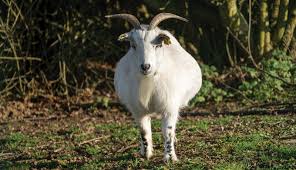
Kidding
What to expect
Kidding refers to the process by which the pregnant goat gives birth to her kids. strong Normal kidding usually occurs between day 145 and 155 of the goat’s pregnancy. | There are several features that you may notice that will tip you off that you need to start preparing for the new kids.
Here are a few of these signs of upcoming kidding and active labor.
- Creamy, gel-like vulval discharge from losing the cervical plug.May happen as early as 1 week before the kidding.
- Tail dropping
- Engorged and hyperpigmented udders. May start producing milk a day or two to the kidding.
- Restlessness including continuous pawing on the ground.
- Self-isolation from other members of the herd.
- Gentle vocalizations. This is common in active labor as the doe experiences contractions.
Once you notice these features, you should immediately start preparing for the delivery as it will be occurring soon. The actual kidding occurs in 3 stages.
The first stage is marked by the start of active contractions. These will increase in intensity and frequency and the stage typically lasts 12 hours or more. The goat will be very restless due to the discomfort. It is also here that they are most likely to isolate themselves. strong The stage ends when the cervix opens | .
The second stage is the actual delivery of the kids. For correctly-positioned fetuses, the front legs will come out first, then the snout and head, then the body and the hind legs. This should ideally not take more than 2 hours.
Prolonged labor is common in cases where the fetus is positioned with the hind feet coming out first. It could also happen if there are inadequate contractions or a narrow cervix. If the labor seems to be taking too long, have your on-call vet come over as the goat may require emergency interventions like a cesarean section.
Finally, the third stage involves the expulsion of the placenta. This can take anywhere from 6 hours to 18 hours.
How to care for the goat
A healthy goat with appropriately-positioned fetuses will usually deliver the kids unaided and without complications. The most you can do is to support them by keeping them safe, warm, and comfortable.
You could also help the goat dry and warm up her new kids by drying them with a clean and dry towel. This is particularly useful if your goat is delivering multiple kids where they may not be able immediately tend to each kid as they are delivered.
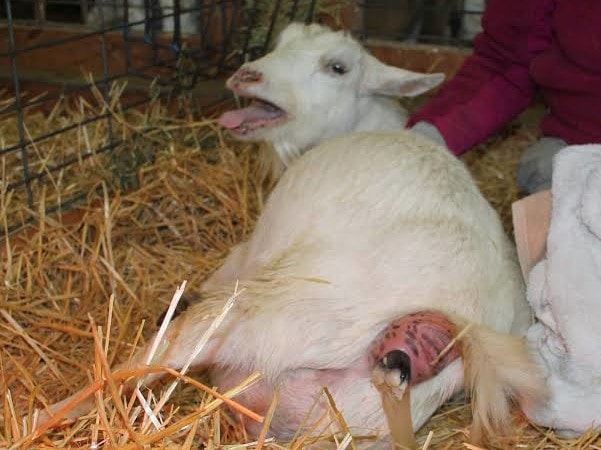
Postpartum And Neonatal Period
What to expect
Good postpartum and neonatal cate for the goat and their kids is all about understanding what risks to look out for and knowing how to prevent such outcomes. In this section, we shall take a look at some of these likely issues then cover tips to help you take good care of the new goat family.
Here are some of the likely postpartum complications for the doe.
Pregnancy and breastfeeding toxemia
Toxemia occurs when the goat does not get enough nutrition to match their increased energy requirements. It is common during breastfeeding but can also be seen in the late pregnancy stage as both the goat and fetuses experience growth surges.
The toxemia presents with features like reduced coordination, tremors, circling behavior, and eventually, death.
Hemorrhage
Post-partum hemorrhage is a life-threatening complication of kidding where the goat ends up losing a lot of blood for any number of reasons from traumatic deliveries to a retained placenta. Here, prompt veterinary care is crucial to helping improve the survival rates for the goat.
Mastitis
Mastitis is the inflammation of the goat’s udders. You may notice the goat is restless and in apparent distress especially while breastfeeding. They may actually completely refuse to breastfeed the kids due to the discomfort.
You may also notice features of inflammation including swelling, redness, and warmth over the affected teats.
Vaginal prolapse
Vaginal prolapse after kidding can affect any goat. However, it is most commonly seen in goats that had multiple fetuses. It is also common after prolonged labor with a lot of straining on the goat’s part. This is another complication whose only solution is veterinary care.
Let’s now take a look at what could go wrong for the new kids.
Infection of the umbilicus
The umbilicus of the newborn kid should be left intact to prevent bleeding and exposure to pathogens. Eventually, the umbilicus will wither and die on its own.
However, in some instances, the umbilicus may get contaminated resulting in infections that could be life-threatening for the kid.
Poor feeding
Poor feeding typically occurs when the goat has multiple kids and thus there is higher competition for the available space around the udders.
In other cases, the goat simply refuses to acknowledge the kid as their own especially if there was prolonged separation immediately after the kidding.
The poor feeding compromises not only the kid’s growth and development but also their immunity as the goat’s milk is rich in antibodies
How to care for the goat and newborn kids
Taking care of the newborn kids and the goat is all about being vigilant and keeping an eye out for any signs of the above possible complications. Here are a few more tips that should help.
- Feed your goat adequately with hay, grains, and minerals.
- Give the goat a clean and warm space to nurse their newborn kids.
- Clean the umbilical cord with chlorhexidine or diluted iodine solution.
- Ensure that all kids start breastfeeding as early as possible.
- Monitor for any complications and have a vet on standby.
